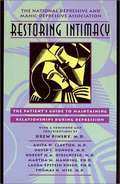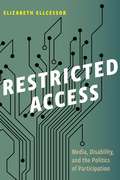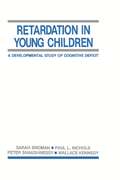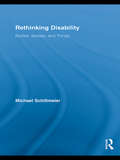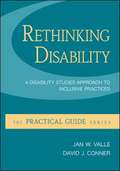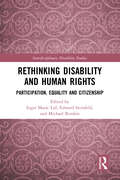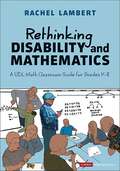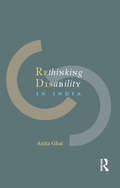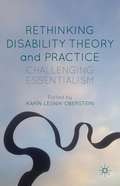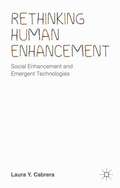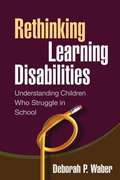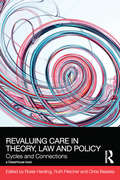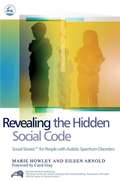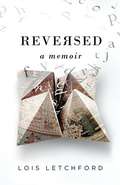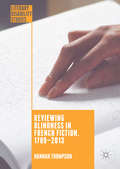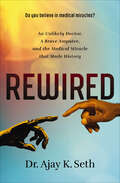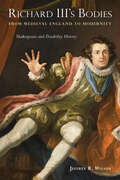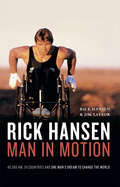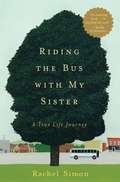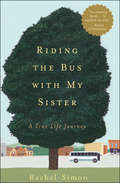- Table View
- List View
Restoring Intimacy: The Patient's Guide to Maintaining Relationships during Depression
by National Depressive And Manic-Depressive AssociationThe strongest of personal relationships are tested by depression. Depression leaves partners, friends, and loved ones with many questions, and few comfortable places to turn for answers.
Restricted Access: Media, Disability, and the Politics of Participation (Postmillennial Pop #6)
by Elizabeth EllcessorWhile digital media can offer many opportunities for civic and cultural participation, this technology is not equally easy for everyone to use. Hardware, software, and cultural expectations combine to make some technologies an easier fit for some bodies than for others. A YouTube video without closed captions or a social network site that is incompatible with a screen reader can restrict the access of users who are hard of hearing or visually impaired. Often, people with disabilities require accommodation, assistive technologies, or other forms of aid to make digital media accessible--useable--for them. Restricted Access investigates digital media accessibility--the processes by which media is made usable by people with particular needs--and argues for the necessity of conceptualizing access in a way that will enable greater participation in all forms of mediated culture. Drawing on disability and cultural studies, Elizabeth Ellcessor uses an interrogatory framework based around issues of regulation, use, content, form, and experience to examine contemporary digital media. Through interviews with policy makers and accessibility professionals, popular culture and archival materials, and an ethnographic study of internet use by people with disabilities, Ellcessor reveals the assumptions that undergird contemporary technologies and participatory cultures. Restricted Access makes the crucial point that if digital media open up opportunities for individuals to create and participate, but that technology only facilitates the participation of those who are already privileged, then its progressive potential remains unrealized. Engagingly written with powerful examples, Ellcessor demonstrates the importance of alternate uses, marginalized voices, and invisible innovations in the context of disability identities to push us to rethink digital media accessibility.
Retardation in Young Children: A Developmental Study of Cognitive Deficit
by Sarah H. Broman Paul L. Nichols Peter Shaughnessy Wallace KennedyResults of the Collaborative Perinatal Project report disclose the risk factors for mental retardation found in children examined from the prenatal period to age seven. Both biological and social risk factors are analyzed for both severe and mild cognitive deficits. The authors of this volume investigated the etiologies of the neurological subgroups of the retarded and reveal, through comparisons with non-retarded groups, important population factors related to normal cognitive development.
Retarded isn't Stupid, Mom!
by Sandra Z. Kaufman'At 2 she was labeled mentally retarded - at 22 she was living alone.' At the tender age of 2 after months of worry it was discovered that Nicole, born 1955 was mentally retarded. Despite this, she did not allow it to hinder her life and took what people said about her with a pinch of salt, always full of determination and independence to enable her to live a normal life, constantly combating problems provided by other people. She wishes for her achievements to be passed onto other families who are in similar circumstances, and how even with difficulties it is possible to live a normal life.
Retarded Kids Need to Play: A Manual for Parents and Other Teachers
by Cyntha C. Hirst Elaine MichaelisThis book is written for the parents of retarded children, and for any other person who will be involved with teaching sport skills and physical education to the retarded. It presents a program of physical education activities which will help the retarded child develop those physical education skills necessary for enjoyable living.
Rethinking Disability: Bodies, Senses, and Things (Routledge Studies in Science, Technology and Society)
by Michael SchillmeierThis text is a critical and empirically-based introduction to disability studies. It offers a comprehensive, book-length analysis of disability through the lens of Science and Technology Studies (STS), and presents a practice-oriented discussion of how bodies, senses and things are linked in everyday life and configure "enabling" and "disabling" scenarios. Relevant to a broad spectrum of medical practitioners and practicing social service workers, the book will also be essential reading in the fields of disability studies, sociology of the body/senses, medical sociology and STS.
Rethinking Disability: A Disability Studies Approach to Inclusive Practices
by Jan Valle David ConnorIn a series aimed at pre-service and beginning in-service teachers that is meant to boost teacher retention, this volume by Valle (City College, City U. of New York) and Conner (Hunter College, City U. of New York) brings together theory and practice in explaining how and why to implement inclusive education. They discuss inclusion through the frame of disability studies in education, which offers new ways to think about disability as a marker of identity and inclusive practices through a social model. They address the effects of teachers' knowledge, beliefs, and values on practice; misperceptions of disability; problems with the medical model of disability; how to create inclusive classrooms through classroom culture, assessment, and co-teaching; and acknowledging disability as part of diversity. Annotation ©2010 Book News, Inc. , Portland, OR (booknews. com)
Rethinking Disability and Human Rights: Participation, Equality and Citizenship (Interdisciplinary Disability Studies)
by Inger Marie Lid Edward Steinfeld Michael RembisThis book examines the role of disability in the right to political and social participation, an act of citizenship that many disabled people do not enjoy.The disability rights movement does not accept the use of disability to create limits on citizenship, which poses challenges for contemporary societies that will become ever greater as the science and technology of enhancing human abilities evolves. Comprised of eight chapters, three interludes, and a postscript written by leading scholars and disability rights activists, the book explores citizenship for people with disabilities from an interdisciplinary perspective using the United Nations Convention on the Rights of Persons with Disabilities (CRPD) as a point of departure and the concept of universal design as a strategy for actualizing full citizenship for all. Situating disability in its historical and cultural contexts, the authors offer directions for rethinking citizenship, including implications for access to the built environment, information and communication systems, education, work, community life and politics. This book will be of interest to all scholars and students working in disability studies, planning, architecture, public health, rehabilitation, social work, and education.
Rethinking Disability and Mathematics: A UDL Math Classroom Guide for Grades K-8 (Corwin Mathematics Series)
by Rachel LambertEvery child has a right to make sense of math, and to use math to make sense of their worlds. Despite their gifts, students with disabilities are often viewed from a deficit standpoint in mathematics classrooms. These students are often conceptualized as needing to be fixed or remediated. Rethinking Disability and Mathematics argues that mathematics should be a transformative space for these students, a place where they can discover their power and potential and be appreciated for their many strengths. Author Rachel Lambert introduces Universal Design for Learning for Math (UDL Math), a way to design math classrooms that empowers disabled and neurodiverse students to engage in mathematics in ways that lead to meaningful and joyful math learning. The book showcases how UDL Math can open up mathematics classrooms so that they provide access to meaningful understanding and an identity as a math learner to a wider range of students. Weaved throughout the book are the voices of neurodiverse learners telling their own stories of math learning. Through stories of real teachers recognizing the barriers in their own math classrooms and redesigning to increase access, the book: Reframes students with disabilities from a deficit to an asset perspective, paving the way for trusting their mathematical thinking Offers equitable math instruction for all learners, including those with disabilities, neurodiverse students, and/or multilingual learners Applies UDL to the math classroom, providing practical tips and techniques to support students′ cognitive, affective, and strategic development Immerses readers in math classrooms where all students are engaged in meaningful mathematics, from special education day classes to inclusive general education classrooms, from grades K-8. Integrates research on mathematical learning including critical math content such as developing number sense and place value, fluency with math facts and operations, and understanding fractions and algebraic thinking. Explores critical issues such as writing IEP goals in math This book is designed for all math educators, both those trained as general education teachers and those trained as special education teachers. The UDL Math approach is adapted to work for all learners because everyone varies in how they perceive the world and in how they approach mathematical problem solving. When we rethink mathematics to include multiple ways of being a math learner, we make math accessible and engaging for a wider group of learners.
Rethinking Disability and Mathematics: A UDL Math Classroom Guide for Grades K-8 (Corwin Mathematics Series)
by Rachel LambertEvery child has a right to make sense of math, and to use math to make sense of their worlds. Despite their gifts, students with disabilities are often viewed from a deficit standpoint in mathematics classrooms. These students are often conceptualized as needing to be fixed or remediated. Rethinking Disability and Mathematics argues that mathematics should be a transformative space for these students, a place where they can discover their power and potential and be appreciated for their many strengths. Author Rachel Lambert introduces Universal Design for Learning for Math (UDL Math), a way to design math classrooms that empowers disabled and neurodiverse students to engage in mathematics in ways that lead to meaningful and joyful math learning. The book showcases how UDL Math can open up mathematics classrooms so that they provide access to meaningful understanding and an identity as a math learner to a wider range of students. Weaved throughout the book are the voices of neurodiverse learners telling their own stories of math learning. Through stories of real teachers recognizing the barriers in their own math classrooms and redesigning to increase access, the book: Reframes students with disabilities from a deficit to an asset perspective, paving the way for trusting their mathematical thinking Offers equitable math instruction for all learners, including those with disabilities, neurodiverse students, and/or multilingual learners Applies UDL to the math classroom, providing practical tips and techniques to support students′ cognitive, affective, and strategic development Immerses readers in math classrooms where all students are engaged in meaningful mathematics, from special education day classes to inclusive general education classrooms, from grades K-8. Integrates research on mathematical learning including critical math content such as developing number sense and place value, fluency with math facts and operations, and understanding fractions and algebraic thinking. Explores critical issues such as writing IEP goals in math This book is designed for all math educators, both those trained as general education teachers and those trained as special education teachers. The UDL Math approach is adapted to work for all learners because everyone varies in how they perceive the world and in how they approach mathematical problem solving. When we rethink mathematics to include multiple ways of being a math learner, we make math accessible and engaging for a wider group of learners.
Rethinking Disability in India
by Anita GhaiMoving away from clinical, medical or therapeutic perspectives on disability, this book explores disability in India as a social, cultural and political phenomenon, arguing that this `difference' should be accepted as a part of social diversity. It further interrogates the multiple issues of identification of the disabled and the forms of oppressio
Rethinking Disability Theory and Practice
by Karín Lesnik-ObersteinDrawing from work in a wide range of fields, this book presents novel approaches to key debates in thinking about and defining disability. Differing from other works in Critical Disability Studies, it crucially demonstrates the consequences of radically rethinking the roles of language and perspective in constructing identities.
Rethinking Human Enhancement: Social Enhancement and Emergent Technologies
by Laura Y. CabreraThis book discusses three possible human enhancement paradigms and explores how each involves different values, uses of technology, and different degrees and kinds of ethical concerns. A new framework is advanced that promotes technological innovation that serves the improvement of the human condition in a respectful and sustainable way.
Rethinking Learning Disabilities: Understanding Children Who Struggle in School
by Deborah WaberExperts have yet to reach consensus about what a learning disability is, how to determine if a child has one, and what to do about it. Leading researcher and clinician Deborah Waber offers an alternative to the prevailing view of learning disability as a problem contained within the child. Instead, she shows how learning difficulties are best understood as a function of the developmental interaction between the child and the world. Integrating findings from education, developmental psychology, and cognitive neuroscience, she offers a novel approach with direct practical implications. Detailed real-world case studies illustrate how this approach can promote positive outcomes for children who struggle in school.
Retrolental Fibroplasia and Autistic Symptomatology: An Investigation into Some Relationships Among Neonatal, Environmental, Developmental and Affective Variables in Blind Prematures
by Joan B. ChaseIn this monograph, based on a study of 263 subjects with RLF (Retrolental Fibroplasia-- an eye condition caused by excessive incubator oxygen), the author examines selected variables which may significantly affect subsequent development.
ReValuing Care in Theory, Law and Policy: Cycles and Connections (Social Justice)
by Chris Beasley Rosie Harding Ruth FletcherCare is central to life, and yet is all too often undervalued, taken for granted, and hidden from view. This collection of fourteen substantive and highly innovative essays, along with its insightful introduction, seeks to explore the different dimensions of care that shape social, legal and political contexts. It addresses these dimensions in four key ways. First, the contributions expand contemporary theoretical understandings of the value of care, by reflecting upon established conceptual approaches (such as the ‘ethics of care’) and developing new ways of using and understanding this concept. Second, the chapters draw on a wide range of methods, from doctrinal scholarship through ethnographic, empirical and biographical research methodologies. Third, the book enlarges the usual subjects of care research, by expanding its analysis beyond the more typical focus on familial interconnection to include professional care contexts, care by strangers and care for and about animals. Finally, the collection draws on contributions from academics working in Europe and Australia, across law, anthropology, gender studies, politics, psychology and sociology. By highlighting the points of connection and tension between these diverse international and disciplinary perspectives, this book outlines a new and nuanced approach to care, exploring contemporary understandings of care across law, the social sciences and humanities.
Revealing the Hidden Social Code: Social Stories (TM) for People with Autistic Spectrum Disorders
by Marie Howley Eileen ArnoldThe Social Stories(TM) approach is widely acknowledged as a key technique for teaching social and life skills to children with autistic spectrum disorders. This text, endorsed by the originator of Social Stories(TM), Carol Gray, offers clear and comprehensive guidance for professionals, parents and carers on how to write successful and targeted Social Stories(TM) that will help develop the autistic spectrum child's understanding of social interaction. The book outlines the kinds of social challenges that people with ASD may experience and highlights the importance of learning social skills in meaningful contexts. An extended review of the guidelines for writing Social Stories(TM) will help writers to structure and develop their stories. The authors explain the key elements and highlight the potential difficulties that a writer may encounter, while providing encouragement and guidance through the various stages of what is often a challenging process. They include examples from their own professional experience, and suggest ways in which the Social Stories(TM) approach may enhance other strategies. Helpful advice on presentation and implementation is provided. Revealing the Hidden Social Code is essential reading for any professional, parent, carer or teacher wanting to employ Social Stories(TM) to develop social understanding in people with ASDs.
Reversed: A Memoir
by Lois LetchfordIn 1995, the school diagnostician called a seven-year-old “the worst child seen in 20 years of teaching.” Can a child’s fate be sealed by such a diagnosis? Well, in 2018, that boy received a Ph.D. from Oxford University. Do you have a child struggling with reading? What labels has your child been given? How do you feel they will progress through school? This is a story for you. Every parent has high hopes for their children. When Lois Letchford learns her son has been diagnosed with a low IQ at the end of grade one, she refuses to give up on his future. After thorough testing, Nicholas proves to have no spatial awareness, limited concentration, and can only read ten words. Although discouraged, Lois knows things have to improve. After all, her son is young, and every child learns at their own pace. But once Nicholas is labeled "learning disabled," a designation considered more derogatory than "dyslexia," the world of education is quick to cast him aside. Determined to prove them all wrong, Lois temporarily removes her son from the school system and begins working with him one-on-one. She has no formal reading education herself, and no one to guide her. But she has hope and the strength of will to persevere. And sometimes that's all you need. What happens next is a journey—spanning three continents, unique teaching experiments, never-ending battles with the school system, a mother’s discovery of her own learning blocks, and a bond fueled by the desire to rid Nicholas of the “disabled” label. "Reversed" is a memoir of profound determination that follows the highs and lows of overcoming impossible odds, turning one woman into a passionate teacher for children who have been left behind. Nothing is impossible when one digs deep, and looks at students through a new lens.
Reviewing Blindness in French Fiction, 1789–2013
by Hannah ThompsonThis book argues that the most interesting depictions of blindness in French fiction are those which call into question and ultimately undermine the prevailing myths and stereotypes of blindness which dominate Western thought. Rather than seeing blindness as an affliction, a tragedy or even a fate worse than death, the authors examined in this study celebrate blindness for its own sake. For them it is a powerful artistic and creative force which offers new and surprising ways of describing, and relating to, reality. Canonical and lesser-known novels from a range of genres, including the roman noir, science fiction, auto-fiction and realism are analyzed in detail to show how the presence of blind characters invites the reader to abandon his or her traditional reliance on the sense of sight and engage with the world in sensual, and hitherto unexpected, ways. This book challenges everything we thought we knew about blindness and invites us to revel in the pleasures and perils of reading blind.
Rewired: An Unlikely Doctor, a Brave Amputee, and the Medical Miracle That Made History
by Ajay K. SethA raccoon bite on the arm doesn&’t seem that serious, but it soon becomes a life-or-death medical crisis for Melissa Loomis. After days of treatment for recurring infection, it becomes obvious that her arm must be amputated. Dr. Ajay Seth, the son of immigrant parents from India and a local orthopaedic surgeon in private practice, performs his first-ever amputation procedure. In the months that follow, divine intervention, combined with Melissa&’s determination and Dr. Seth&’s disciplined commitment and dedication to his patients, brings about the opportunity for a medical breakthrough that will potentially transform the lives of amputees around the world.Rewired is the inspirational, miraculous story of Dr. Seth&’s revolutionary surgery that allows Melissa to not just move a prosthetic arm simply by thinking, but to actually feel with the prosthetic hand, just as she would with her natural arm. This resulted in what others have recognized as the world&’s most advanced amputee, all done from Dr. Seth&’s private practice in a community hospital, using a local staff, and with no special training or extensive research funding.
Richard III's Bodies from Medieval England to Modernity: Shakespeare and Disability History
by Jeffrey R. WilsonRichard III will always be central to English disability history as both man and myth—a disabled medieval king made into a monster by his nation’s most important artist. In Richard III’s Bodies from Medieval England to Modernity, Jeffrey Wilson tracks disability over 500 years, from Richard’s own manuscripts, early Tudor propaganda, and x-rays of sixteenth-century paintings through Shakespeare’s soliloquies, into Samuel Johnson’s editorial notes, the first play produced by an African American Theater company, Freudian psychoanalysis, and the rise of disability theater. For Wilson, the changing meanings of disability created through shifting perspectives in Shakespeare’s plays prefigure a series of modern attempts to understand Richard’s body in different disciplinary contexts—from history and philosophy to sociology and medicine. While theorizing a role for Shakespeare in the field of disability history, Wilson reveals how Richard III has become an index for some of modernity’s central concerns—the tension between appearance and reality, the conflict between individual will and external forces of nature and culture, the possibility of upward social mobility, and social interaction between self and other, including questions of discrimination, prejudice, hatred, oppression, power, and justice.
Rick Hansen: Man in Motion
by Jim Taylor Rick HansenIn 1973, Rick Hansen was a carefree teenager hitchhiking home from a fishing trip, a kid who lived and breathed sports. But after the truck he was riding in went out of control and crashed, Hansen was left a paraplegic.<P><P> For some people that could have been the end. For Rick Hansen it was the beginning of a story that is at once sad and funny, heartbreaking and inspirational.Hansen takes you from the first painful days and frightening nights in hospital, through the gritty process of rehabilitation, to his return to competition as a world champion of wheelchair sports. It is the story of the Man in Motion tour-Rick Hansen's incredible 24,901.55-mile wheelchair journey through 34 countries around the world. It is also the love story of Hansen and his wife, Amanda, a physiotherapist whom Hansen calls his "lifeline." And it is a success story-Rick Hansen has raised millions of dollars for spinal cord research, rehabilitation and wheelchair sports as well as raised awareness about the disabled.
Rick's Carrot: Targeting the r Sound (Speech Bubbles 2)
by Melissa PalmerRick is hungry, but his carrot has disappeared! Who has taken it? Come along on the mission to find it. This picture book targets the /r/ sound and is part of Speech Bubbles 2, a series of picture books that target specific speech sounds within the story. The series can be used for children receiving speech therapy, for children who have a speech sound delay/disorder, or simply as an activity for children’s speech sound development and/or phonological awareness. They are ideal for use by parents, teachers or caregivers. Bright pictures and a fun story create an engaging activity perfect for sound awareness. Picture books are sold individually, or in a pack. There are currently two packs available – Speech Bubbles 1 and Speech Bubbles 2. Please see further titles in the series for stories targeting other speech sounds.
Riding the Bus with My Sister: A True Life Journey
by Rachel SimonThis is an unusual memoir, framed by the year the author spent riding the buses of a Pennsylvania city with her sister Beth. Beth, who has mild mental retardation and lives in her own apartment, spends six days a week riding the buses from route to route. At times the author and the rest of the family are distressed by Beth's lack of purpose and ambition, and press her to get a job. When she agrees to accompany Beth on her rides, the author comes to understand how Beth has built a sense of community through her unconventional lifestyle. The various bus drivers, each portrayed as a unique individual, form a richly varied extended family for this otherwise isolated woman. In spending time with Beth riding the buses, the author opens her life to others and embarks upon her own inner journey.
Riding the Bus with My Sister: A True Life Journey
by Rachel SimonA &“heartwarming, life-affirming&” memoir of a relationship with an intellectually disabled sibling: &“Read this book. It might just change your life&” (Boston Herald). Beth is a spirited woman with an intellectual disability who lives intensely and often joyfully, and spends most of her days riding the buses in Pennsylvania. The drivers, a lively group, are her mentors; her fellow passengers, her community—though some display less patience or kindness than others. Her sister, Rachel, a teacher and writer, camouflages her emotional isolation by leading a hyperbusy life. But one day, Beth asks Rachel to accompany her on public transportation for an entire year—and Rachel accepts. This wise, funny, deeply affecting book is the chronicle of that remarkable time, as Rachel learns how to live in the moment, how to pay attention to what really matters, how to change, how to love—and how to slow down and enjoy the ride. Weaving in anecdotes and memories of terrifying maternal abandonment, fierce sisterly loyalty, and astonishing forgiveness, Rachel Simon brings to light a world that is almost invisible to many people, finds unlikely heroes in everyday life, and, without sentimentality, wrestles with her own limitations and portrays Beth as the endearing, feisty, independent person she is. &“With tenderness and fury, heartbreak and acceptance . . . Simon comes to the inescapable conclusion that we are all riders on the bus, and on the bus we are all the same.&” —Jacquelyn Mitchard, author of The Deep End of the Ocean
